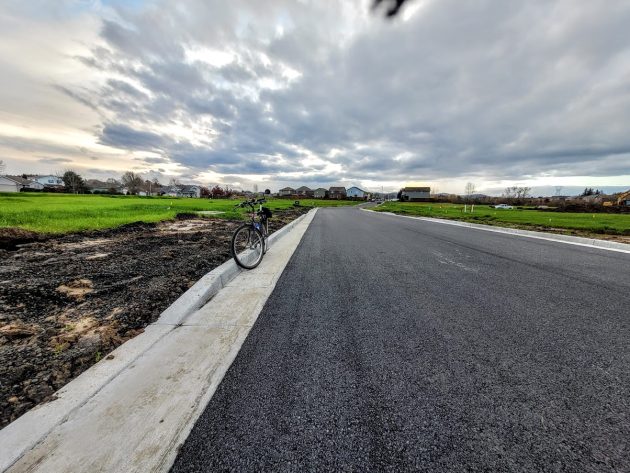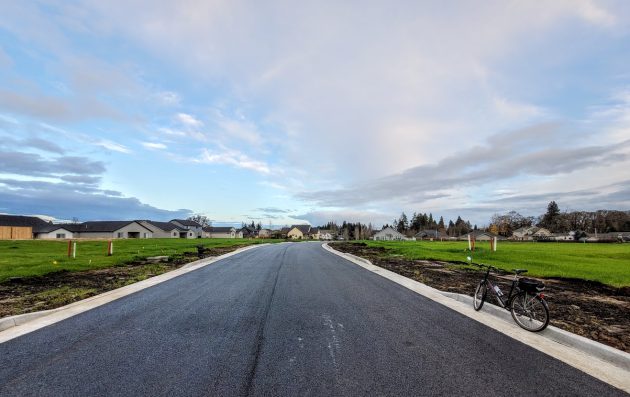
On a new section of N.W. 23rd Avenue on the afternoon of Dec. 8, 2021.
You know what’s kind of fun now and then? It’s to ride your bike on a network of brand new, freshly paved suburban streets before there’s any traffic because the houses have yet to be built.
When you’re doing that, as I was one afternoon last week, don’t think about the expense of building that road, or the price of the houses that will soon be built, or the costs of maintaining those streets in the long run, say 50 years from now, or who is going to get the bill.
If you do think about those things, it tends to spoil the carefree aspect of sailing along on that fresh pavement, as yet unmarred by utility trenches and makeshift patches of asphalt filling the gaps either too high or too low.
The Albany City Council, though, has begun thinking about at least one aspect of this: How the city might slow the rising price of housing. In particular, how to make smaller new houses cost a little less.
What they’re thinking about is lowering the “system development charges” or SDCs the city collects when builders take out permits to construct houses or apartments. On Monday, during a work session, the council heard a detailed presentation on the topic from a consultant. You can catch it on the video posted under city council “meeting materials” on the city website.
Council members seemed to like the idea, at least before they are faced with a concrete proposal. Because there’s a catch. The catch is that SDCs, also called impact fees, are used to help pay for improvements that will become necessary to accommodate the people living in the houses on which the fees were charged.
Keeping the purpose in mind, and to keep from losing revenue, the city staff has suggested raising the fees on bigger dwellings if they are lowered on smaller ones.
At the moment, Albany charges the same impact fees per unit regardless of size, except in the case of the SDC for parks. For parks, the fee is calculated based on both the number of bedrooms and the square footage of the house.
On new houses, Albany now charges systems development charges totaling just under $14,000.
Of that total, about $4,400 is for the street system. About $4,000 is for the water system, and about $4,200 for the sewer system. And if the house has 1,850 square feet and three bedrooms, the park impact fee is about $1,900.
Whether and how much of all that is reflected in the price of the new house is a question for another day.
In the meantime, there are empty streets on which to ride. (hh)

Looking east on the same street as above in the Pheasant Run subdivision.

Nice Hasso. more info to understand a “truism”:
The’re Ain’t No Such Thing As A Free Lunch. TANSTAAFL!
Learned that back in college in the 70’s EVERYTHING has a cost. It all comes down to who pays. That is a political decision.
First, call this “fee” what it is – a tax.
Second, Albany’s council has to decide if a carrot is better than a stick.
Governments love to put their finger on the scale and favor some at the expense of others. Sometimes it works, sometimes it doesn’t.
Rich folks moving to Albany from California or Seattle won’t be disincentivized from building a big house with a higher impact tax. Impact taxes are the least of their concern.
But will a lower impact tax enable those who don’t have much money or income, or a poor credit history, to buy an “affordable” from a developer? I doubt it.
Cash flush folks will scoop up these smaller tax advantaged homes and rent them out at market rates. The lack of “affordable” housing will continue, unless the council also imposes rent controls. And they shouldn’t even open that can of worms.
The bottom line – if Albany can’t afford to grow, or doesn’t want to, then swing a big, ugly stick and dramatically jack up the impact taxes on every new building.
Let other nearby cities deal with paying for expensive infrastructure.
If Albany wants to impose a feel good policy by dangling a carrot, then structure the impact tax to favor smaller houses that less advantaged folks probably can’t afford to buy.
Nobody will monitor or measure the consequence of this policy decision in the future, so politically the carrot probably the better option.
I’ll take the big, ugly stick option.
At the rate things are increasing in cost to maintain, the street, water and sewer “fees” should all start at $10k each since they are one and done income that needs to offset the future costs for maintenance of each of the those items. SDCs of $30k are not going to keep people from buying these houses that likely start in the $400k range anyway when nothing else is available that will meet their wants.